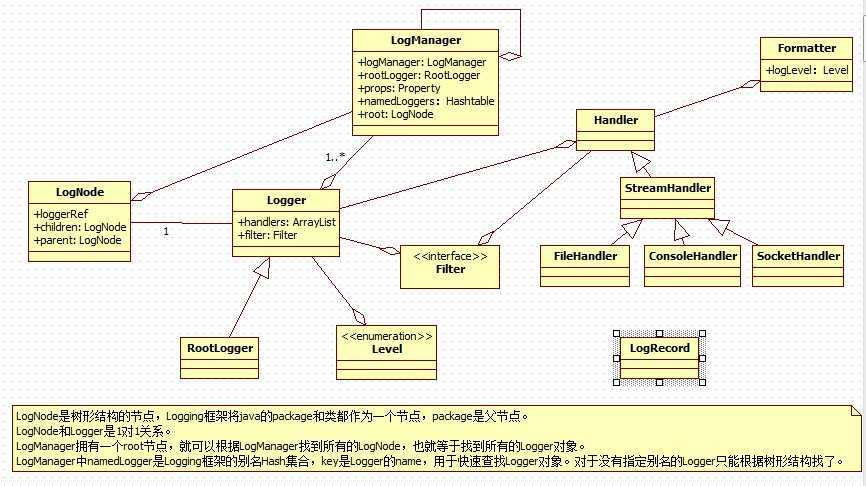标签:des style blog http io color ar os 使用
Java Logging
用惯了log4j等日志工具,竟然不知Java还自带了个log工具。今天有空了就来了解一下。
先来看一个简单的例子:
public class SystemTest { private final Logger logger = Logger.getLogger("alias"); @Test public void showSystemProperty() { Properties props = System.getProperties(); Enumeration<Object> keysIter = props.keys(); System.out.println(logger.getName()); while (keysIter.hasMoreElements()) { Object key = keysIter.nextElement(); logger.info(key + " \t\t: " + props.getProperty(key.toString())); } } }
这个例子可以说是Logging的最简单的用法了。这个看起来和Log4J使用没什么差别呀。
此外,在使用log4j时,需要配置一个Log4j.properties,指定Adpater,指定日志的Pattern,那logging中有没有类似的功能呢?log4j支持命名空间的继承,logging是否支持呢?
基本的知识网上很多:
1)JDK官方文档
2)http://www.vogella.com/tutorials/Logging/article.html
3)http://en.wikipedia.org/wiki/Java_logging_framework

所谓的日志环境初始化,其实就是LogManager初始化。通过源码阅读,LogManager初始化的过程是:
1.1通过类加载器,加载LogManager
可以自定义LogManager,自定义的LogManager要继承java.util.logging.LogManager。如果没有自定义的LogManager类,就加载默认的LogManager。
可以通过配置系统属性java.util.manager
1.2通过反射机制创建LogManager对象
1.3创建RootLogger,并从配置文件中读取日志的属性
RootLogger其实是一个Logger的子类。它的name是“”,默认级别是INFO。
并且还要读取配置文件,配置文件可以是一个配置类,也可以是一个属性文件。
下面就单说属性文件这种配置文件。
属性文件的位置是通过系统属性来指定,它的系统属性名是:java.util.logging.config.file
如果没有自定义配置文件,就从JAVA_HOME\lib目录下读取logging.properties文件。
下面可以看看默认的配置:
############################################################ # Default Logging Configuration File # # You can use a different file by specifying a filename # with the java.util.logging.config.file system property. # For example java -Djava.util.logging.config.file=myfile ############################################################ ############################################################ # Global properties ############################################################ # "handlers" specifies a comma separated list of log Handler # classes. These handlers will be installed during VM startup. # Note that these classes must be on the system classpath. # By default we only configure a ConsoleHandler, which will only # show messages at the INFO and above levels. handlers= java.util.logging.ConsoleHandler # To also add the FileHandler, use the following line instead. #handlers= java.util.logging.FileHandler, java.util.logging.ConsoleHandler # Default global logging level. # This specifies which kinds of events are logged across # all loggers. For any given facility this global level # can be overriden by a facility specific level # Note that the ConsoleHandler also has a separate level # setting to limit messages printed to the console. .level= INFO ############################################################ # Handler specific properties. # Describes specific configuration info for Handlers. ############################################################ # default file output is in user‘s home directory. java.util.logging.FileHandler.pattern = %h/java%u.log java.util.logging.FileHandler.limit = 50000 java.util.logging.FileHandler.count = 1 java.util.logging.FileHandler.formatter = java.util.logging.XMLFormatter # Limit the message that are printed on the console to INFO and above. java.util.logging.ConsoleHandler.level = INFO java.util.logging.ConsoleHandler.formatter = java.util.logging.SimpleFormatter ############################################################ # Facility specific properties. # Provides extra control for each logger. ############################################################ # For example, set the com.xyz.foo logger to only log SEVERE # messages: com.xyz.foo.level = SEVERE
可以使用Logger的构造器创建对象,也可以使用Logger.getLogger(name)来创建对象。
添加logger对象时,会根据配置文件来设置日志级别,相关Handler的。
1) 根据消息内容创建LogRecord对象。
2) 使用Logger的过滤器filter进行过滤。
3)使用与该Logger对象所有相关的Handler进行日志处理并写到相应的位置。
这篇笔记写的偏向总结化,这些都是我通过源码查看得知的,不想戰源码充篇幅。上面给出的链接中有相关的例子。
标签:des style blog http io color ar os 使用
原文地址:http://www.cnblogs.com/f1194361820/p/4083646.html